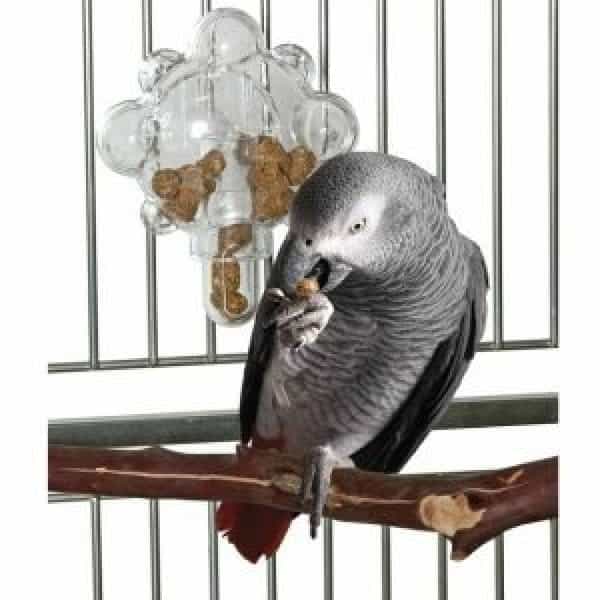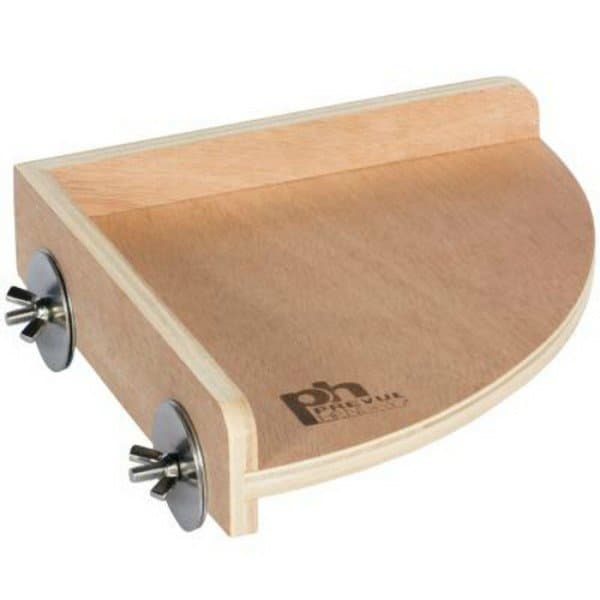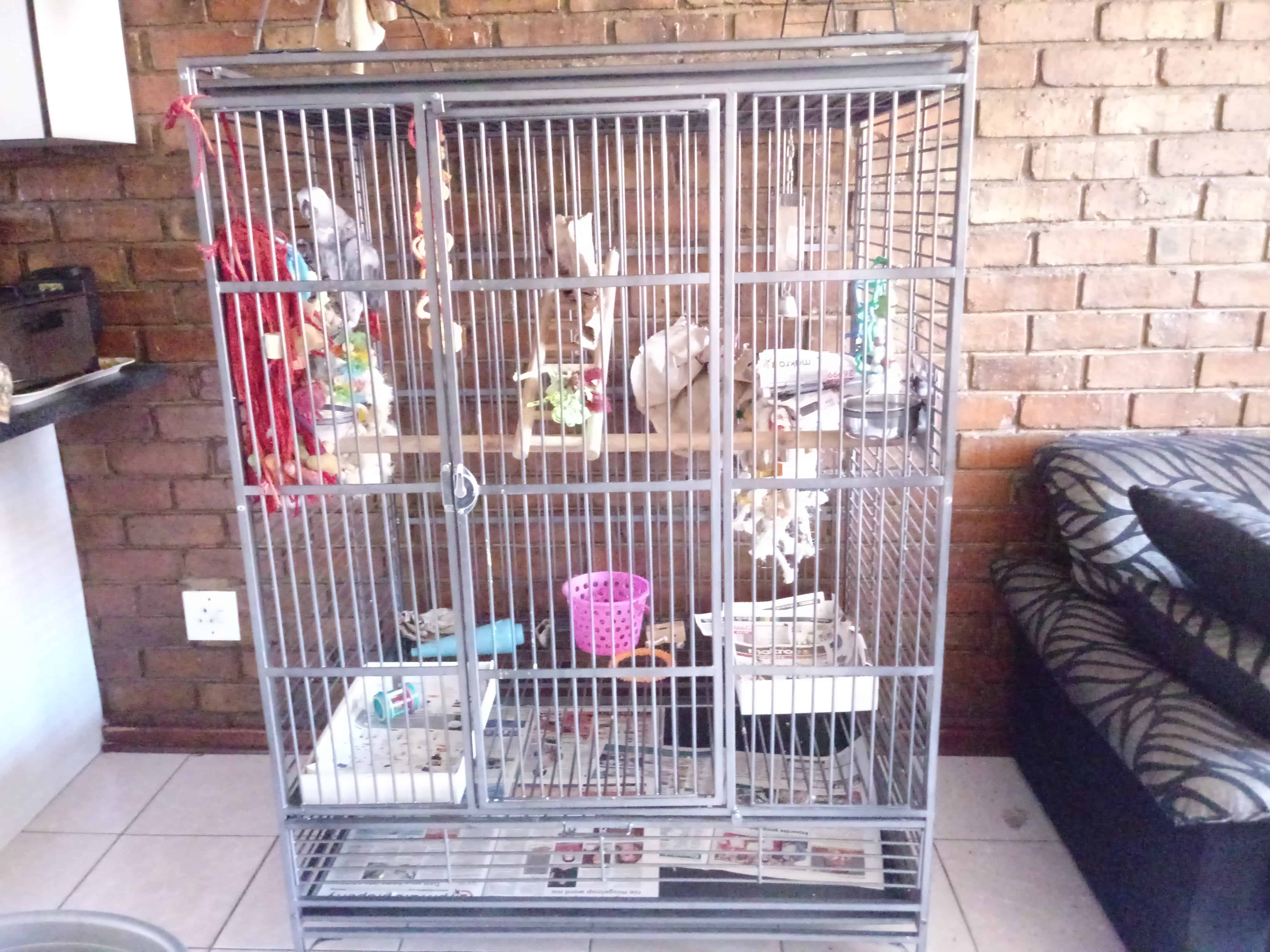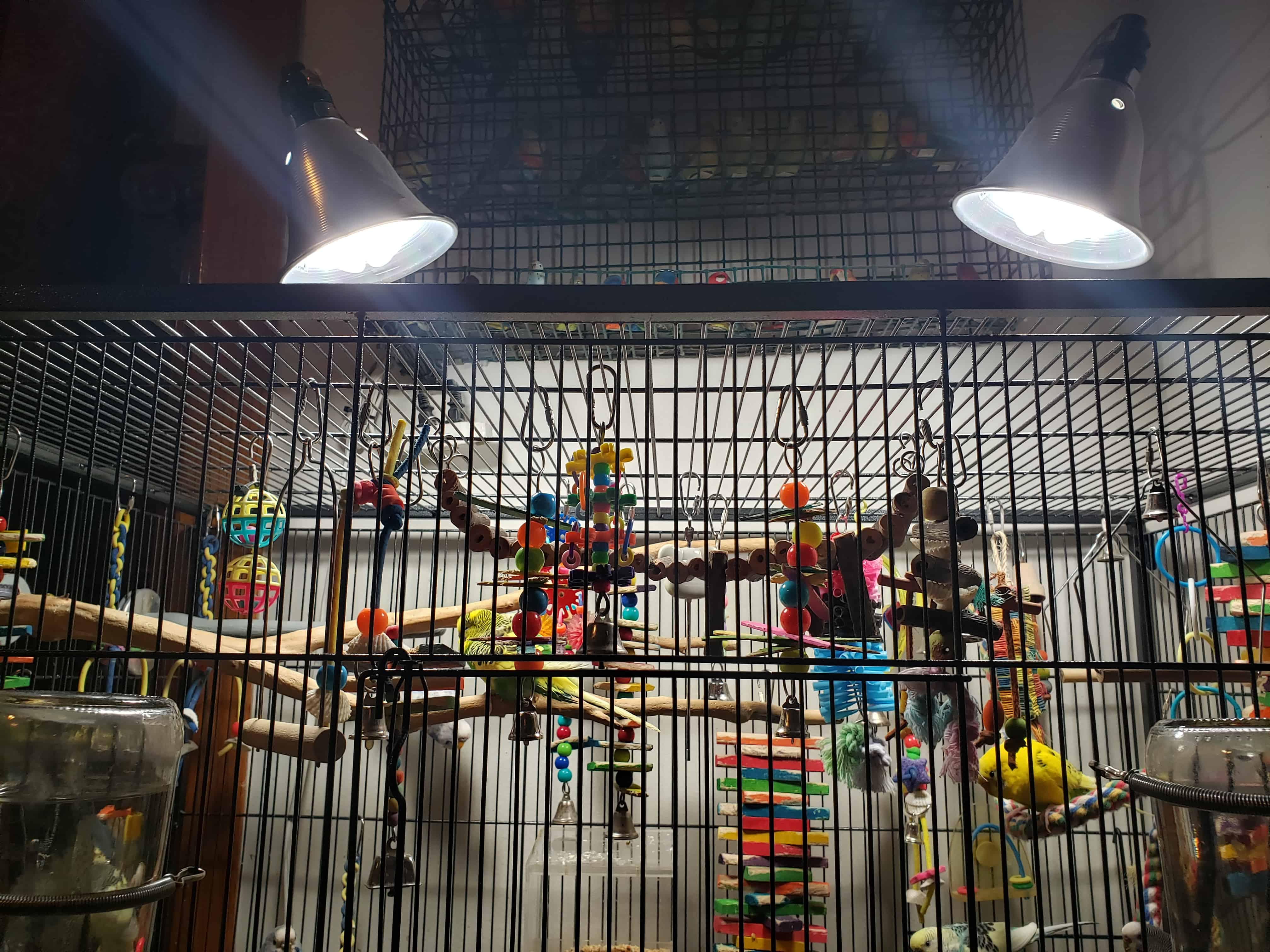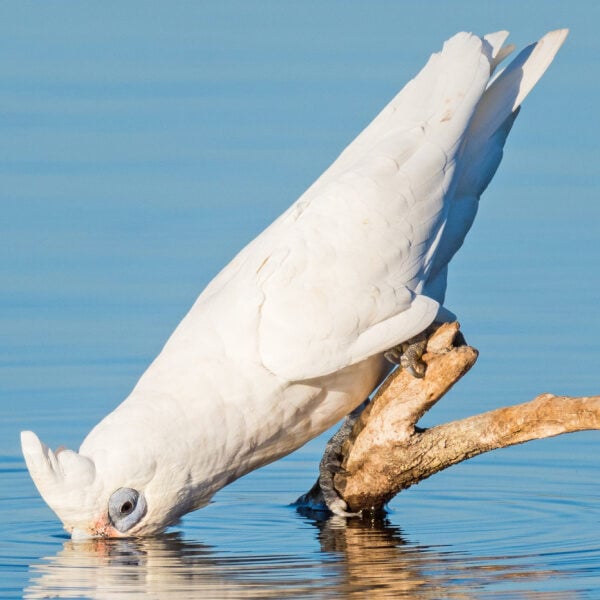Last Updated on by Mitch Rezman
Spoiler alert: This post and discussion illustrate how I reached my diagnosis:
Jan is plucking his feathers because his feet hurt.He’s using his food dish to sleep.This helps avoid pressure to the bottom of his feet which he feels when they grip the smooth dowel rod perch.That’s why he plucks in the sleeping cage – he wants the pain to ease.
Editor’s note: The problem with comments placed at the bottom of a blog post is that recent ones tend to get overlooked so I’m going to post these eloquent comments at the top of this page.
From Mary L
Hello – first I enjoy your weekly emails.
Regarding feather picking in African Greys.
I have 2 Congo Greys (one a rescue) & a Timneh Grey also a rescue.
In addition a Quaker & a Senegal (both from rescues).
All live in the basement of our home in a flock.
My husband changes the papers weekdays & I clean more thoroughly on weekends.
When I come home from work around 5 I open the cages for them to choose to come out which they do.
Also, the cat’s cruise thru & also the dogs who love to pick up food droppings.
No aggression all respect/accept as family.
My birds watch public TV during the day, TV at night with me or listen to classical music with me while I work on my computer & after they are covered at night regularly classical radio around 8 PM.
Also when it gets chilly turn on the gas fireplace. they are uncovered around 7-8 AM.
They are all 20 yrs. plus & thankfully have not feather picked.
They appear happy with their flock & setting.
Might all of that have prevented feather picking?
I do believe that a single bird is not a happy bird – they need another feathered friend.
Thank for reading.
My birds are healthy, vocal & in good feather.
From Elouise M
Agreed – mitchr
New comment
Good article.
My grey feather plucker from 20 years ago was given Haldol in an attempt to modify her plucking and from the day she took the first dose, she stopped talking.
She has not learned a new word in 20 years and prior to was speaking new words often.
She still says some of her old words “are you hungry” but it’s rare.
I wish I had never given it to her.
She rarely plucks anymore although there is little left to pluck.
The feathers never grew back in properly and she had so many ingrown feathers that by the time the vet got done opening those up and treating them that side of the wing has little left.
Amazingly her other wing is as perfect as they come. She is perfect in every other way and I delight when she does talk
End top comments
I am sorry to hear of this but not surprised
Start article
We’ve been jumping into new approaches that can stop feather self-destruction but we feel they are extreme and detrimental to pet birds.
Drugs like Haldol and Prozac are being used to calm birds and eliminate plucking.
They work – but what price do our animals pay?
We need to start at the very, very beginning.
Birds have 120 million years of instinctual expectations which are not being met by we humans.
Environmental issues like
- Improper placement of the birdcage
- Erratic light cycles
- Abundant food
- Poor nutrition
- Boredom
- Wrong bird toys and accessories
- Inappropriate perch selection and placement
- Exposure to cooking fumes
will negatively affect your bird’s mental health.
We view your pet bird’s environment holistically.
- Nutrition
- Cage environment
- Lighting/light cycles
- Out of the cage environment
- Whether clipped or flighted
- Training
- Sexuality
- Species
- Foraging & enrichment opportunities
- Exercise
- Frequency of bathing
- Other feathered flock members
- Human flock members
More info on holistic pet bird care found here
Too often we impose our anthropomorphic footprints upon the delicate creatures and inevitably they have a (backward) knee-jerk reaction.
Our birds want to fly freely every day seeking food – We clip their wings so they don’t hurt themselves whilst in flight.
We allow our birds to sleep on a grooming perch -10 years later their feet are blistered and arthritic.
How about we fix all starting now?
The three of us me you and your bird are going to begin to understand what we expect from one another.
We will learn to let your expectations shift as you interpret environmental data is your bird does, not as a human.
I’ve often said the perfect size bird cage is roughly 50 square miles.
We need to convince the bird that does not get 50 square miles but 12 square feet (that’s a 3-foot x 4-foot cage) that it will be fine.
This synchronicity can’t be done with words alone.
Your birdcage and where it sits in your local universe needs to make sense for both you and your pet bird.
We can no longer sit back and watch while pharmaceuticals are being injected into our FIDS in the “hope” that feather destruction or prolific egg laying will stop.
We are in an opiate crisis in this country for the same reasons our birds are being drugged.
Don’t get me wrong pharmaceuticals have their place but birds did not display any of these current negative activities until humans got a hold of them.
Much like using Environmental Nanotechnology for generating less pollution during the manufacture of materials, who is going to learn how to create the (near) perfect nano environment for your bird in your home?
The thread you are about to read could be yours.
A pet bird keeper that is doing everything right and yet everything is going terribly wrong with the bird.
We’re going to break this down to the most granular level.
Will we be effective in blocking feather self-destruction and rebuilding the bird’s feathered Integumentary system?
Follow along and let us know how we’re doing (in the comments below).
We are about to offer our in-home analysis of your bird’s environment through the use of images and video as a paid service.
Theresa B is our first beta tester
Good day
My 12-year-old African grey has plucked its feathers for the past 3 years.
We have visited the vet (avian vet)at least 4 times in a month.
From tranquilizers to vitamins and CBD oil……you name it and we have done it.
He refuses to eat his veggies and fruit unless we eat fruit, he will eat with us.
He will not have them in his cage as he ignores his food in the cage completely.
I give him Lifegain porridge in the mornings and add a sprinkle of feather mold into that.
Also add some pellets into his porridge, as this is the only way he eats his pellets.
He likes apple and grapes.
During the day he gets a spoon of yogurt which he loves.
He is also keen to have a bit of cheese now and then.
I have read your article…….and found it very interesting as we have a fan on during summer times.
I will keep it away from him with immediate effect.
Many thanks
Theresa
can you please send a picture of his cage – I need to see it top to bottom?
thanx
mitchr
Some follow up
- Does he use the playtop much?
- How much out of the cage time does he get?
- If I’m looking at the front of the cage is a window to the right and kitchen on the left?
- Do the toy boxes lower in the cage get soiled?
- What perch does he sleep on?
- Does the cage get covered nightly?
- What’s your zip code?
- How do you know he is a he?
I’ll wait for your answers to begin to sort this out – but your bird is bored for one and the food is not interesting.
Until then here’s a video with some food for thought.
best mitchr
Hi Mitch
- Feedback on your questions.
- He never plays on the play top of his cage…..only sits there, no and again, but really not much.
- He prefers to sit on the top of the open cage door.
- On the left of his cage is the kitchen and he is basically in the lounge and yes there is a window, approx 4 meters away from his cage.
- His cage also has a view down the passage.
I am sending more pics.
The box of toys is usually outside his cage, as he prefers to play in the passage for the one or other reason.
No his toys are not soiled….well not ever….he never gets into the box, but he sits next to the box and plays/destroy.
We rotate the toys in his cage on a regular basis.
His cage is always clean. We do not allow it to be soiled.
He sleeps in a different cage and bedroom at night, which we cover with a blanky.
He previously slept in our bedroom in his sleeping cage (for 9 years)
But the avian vet suggested moving him to another room so that we do not disturb him at night.
He used to sit on a towel when he slept.
Nowadays sits on his water bowl.
So I have added a perch into his sleeping cage. He has a choice of towel, bowl or perch to sit on.
I have added toys in there but he takes no interest …….yet he plays with those toys when they are in his box outside the cage.
He gets a bowl of food in there as well.
He has freedom out of his cage at least 8 hours per day and he has his own favorite spots to sit.
For example, he loves to sit on the shower door, the safety gate at the kitchen door, the burglar bar outside my bedroom window and also the safety gate to the front door.
He has a swing on our front stoop, and I let him sit there in the mornings for a half an hour and then afternoons when the weather is favorable.
In all the abovementioned spots, I can honestly say we can keep an eye on him.
He sits on the kitchen working space in the mornings while making his porridge and our coffee. This is where he eats his porridge. Life gain with a pinch of balanced pellets and a pinch of premolt 5.
He gets apple, grapes, veggies, and cooked grain into his food bowl for the day, but does not touch it.
I, however, offer apple to him with my hand and he will eat that as well as grapes.
He gets a teaspoon of full cream yogurt (which he eats) during the day.
Early evening as a snack:
One nut…..and then I offer some seed eg: a mix of linseed, alfalfa, chia, white millet, sorghum, hemp etc and into that mix I will add his pellets……..with a couple of unpitted sunflower seeds.
I also cook an egg now and again which I cut in half and it is served in the shell.
Other than that he will sit with us when we eat during the day.
Eggy bread, oats porridge, and whatever we are having……but he seems to be more interested in the protein in our plates when we have dinner.
He does NOT LIKE to bathe…..and will maybe take a bath every 2nd week in his water bowl…..and when he does I give him a nice water container where climbs in without hesitation.
We have been to a couple of vets before and they have all said he appears to be male.
He has a lovely darker coat (if I may call it so).
He has also chosen one of my Maltese dogs as a lover and feeds the dog. Luckily she doesn’t mind.
Thank you for the video about foraging…..much thought.
I realize that my AG is very much bored, yet he has so many toys.
I will definitely place a couple of those mentioned.
Many thanks
This is great, thank you!
I’ll start working on this today – it’ll be a couple of days
Environmental issues like
- Improper placement of birdcage
- Erratic light cycles
- Abundant food
- Poor nutrition
- Boredom
- Wrong bird toys and accessories
- Inappropriate perch selection and placement
- Exposure to cooking fumes
Now that we have some data and intelligence let’s address the factors mentioned above and how they relate to Teresa and her African greys plucking issues.
- Placing a birdcage properly can be a challenge.
We see the birdcage above his in the middle of the room and although it has a wall on the back we always recommend having a second wall to the right or left.
Parrots are prey animals and having privacy and less exposure is very important to them.
A bird can easily be stressed when feeling exposed to the world
Learn more about proper bird cage placement here.
2. Erratic light cycles are always on the top of our list As in North American light cycles.
Days are shorter in the winter longer in the summer.
Birds are always taking in “light data” through their pineal gland behind the right eye.
It helps them determine everything from when to eat to when to molt.
Birds can tell the precise hour and minute of the day but they cannot differentiate days.
Because most parrots are indigenous to the area that’s 40 minutes north and 40 minutes south of the equator, their instinctual expectations are to have 12 hours of light and 12 hours of darkness.
We put them in front of a large window with a lot of light but the North American light cycle coming through that window is bad data, not what the bird is expecting and the first place we look for when trying to resolve negative bird behavior.
This birdcage is subjected to a large bright window about 12 feet to the right.
So not only is the bird getting erratic light data but unbeknownst any humans have the birds seen any birds of prey fly by that large window?
That could be a plucking trigger.
There is no artificial lighting over the cage and the tray on the upper portion of the cage is installed.
I personally like to remove that tray allowing the bird more light and a feeling of more room in his very confined space.
A small piece of newspaper under where the bird sits will reduce the mess.
As for lighting, this is one of my favorite setups over our budgie aviary
This configuration with the bulbs, shades, and timer will run you about 50 bucks, you can find everything pictured above – here.
3. Abundant food
It may seem counterintuitive to not provide ample food to an animal.
Hookbills are hardwired to wake up every day and work for food.
It sounds to me like the bird food dishes in this African grays birdcage always have lots of food making it boring for the bird.
There is a video higher up on the page illustrating that given the choice, birds would rather work for their food using, in this case, many mechanical dispensers.
They walk past the food in the open dishes.
I’m suggesting to Teresa that she makes food harder and more fun.
- Cover the food with newspaper.
- Get some mechanical toys to dispense food.
- Keep the bird food dishes filled to less than 1/3 of their capacity
- Hide treats throughout the cage (think a small stack of bathroom Dixie cups with a nut in between) easily giving the bird opportunities for forging.
4. Poor nutrition
Teresa talks about her many vet visits but nothing is mentioned about any blood workup.
In her detailed descriptions, I’m not seen where the bird is eating properly and getting the right protein, amino acids vitamins and minerals.
African Greys are dusty birds by default but how dry is this birds skin.
I would advocate here introducing something like Avi-Cakes from Lafeber or you can sprinkle excellent powdered supplements like HARI Prime to serve as a birdie treat.
I would use one of the staples that the bird is getting like the porridge and add some coconut oil which would probably melt if the porridge was warm enough.
Plucking can be triggered by something as simple as dry skin.
African grays also have a rather unique molting cycle
Can the constant onslaught of new feather growth be overwhelming the bird, becoming a plucking trigger?
5. Boredom
Look at this picture from the inside of the cage.
In the lower left-hand corner, we can see there is some sort of cardboard objects in a couple of fuzzy toys with an untouched bowl of bird food pellets.
What jumps out at me visually is how everything works like it’s all about the same color.
No vibrant reds and purples.
Parrots are highly visual animals.
The contents of this cage are boring born to look at.
Let’s get some big bold African grey type toys in here for a couple of reasons
Bodacious Bird Toy for Large Parrots – Wood Chimes
A bird is more likely to play with toys that are visually attractive and have multiple materials to chew through.
We also want to use these toys to line the perimeter of the upper one-third of the cage.
Think of bird toys being the means of a tree that your bird would be living on in the wild.
Learn more about building the canopy effect in your birdcage here.
6. Wrong bird toys and accessories
Birdcages should have so many boys lining the upper portion that you can’t see the bird.
We don’t think twice about adding window coverings to every room in our house starting with the bedroom.
We don’t want to be seen by outsiders, and neither do birds.
An abundance of toys provides forging an enrichment while adding privacy at no extra charge.
Speaking of bird toys, decorating or “cagescaping” as I like to say is a method as well as an art form.
Treat the inside of your cage is an ongoing sculpture that is always getting remade.
Bird toys should have many materials from softwood and hardwood to coconut and fiber.
It doesn’t matter birds need to chew.
Check the damage our 10 hooligans caused as they ransacked their aviary – in a good.
We need to learn how to speak bird.
Birds can be very similar while being very different from others of their own species.
Keto our African ringneck chews on nothing but the entertainment itself day in and day out with shiny bells and hard plastic balls
7. Inappropriate perch selection and placement
I only see one perch in this cage.
It is the original dowel rod perch that came with this cage and every cage you will ever buy commercially.
He’s sleeping on his water bowl because he doesn’t have a lot of options in his feet on comparable on a single round perch.
(This may have been corrected in between exchanging information)
We advocate that the perch come out of the cage immediately to be used as a “Mr. friendly rescue stick” so your bird has something to climb onto once he falls behind a piece of furniture.
Multiple textures are important in order to challenge your bird’s feet.
They are on them 24/7.
When I look at a situation like this (in the picture above) I ask how close were the bird’s feet inspected.
It’s not only living on this perch but it’s sleeping on this perch.
This is not a good scenario for bird foot health.
Multiple textures should be offered like manzanita or coffee (hardwood) and soft rope perches like Booda for sleeping.
Ladders are mounted horizontally to provide a great resting spot for the night as Chicken, Waffles, and Jam agree.
Not only are soft rope perches easy and a bird’s feet for nightly use they provide fabric if you will for birds to chew on helping to divert their desire to pluck up on themselves.
For more information about where what and how to place perches in a birdcage – click here.
8. Exposure to cooking fumes
I’m addressing this because the cage is sitting next to the kitchen all the time.
What may be benign airborne particulate to us, every time something is cooked in that kitchen is African grey is just a few feet away.
It sounds as though Teresa eats healthy.
But simply not as simple as sautéing vegetables in oil can produce that sticky feeling you get when an object has been in a kitchen for too long without having been cleaned.
That could end up lining the bird’s respiratory system.
It’s never a good idea to have a bird anywhere near the kitchen when cooking is going on and yet the bird lives here so the effects of cooking are purely conjecture but not something that can be easily ruled out is another feather plucking trigger.
I’m still awaiting additional information from Teresa so we’ll call it a wrap and will follow up with part two in the near future.
written by mitch rezman
approved by catherine tobsing
Theresa responded to more of my questions
Hi Mitch
Author Profile
Latest entries
 The Traveling BirdJune 26, 2025Can You Name 5 Parrot Species That Are Living Wild in the USA?
The Traveling BirdJune 26, 2025Can You Name 5 Parrot Species That Are Living Wild in the USA? Bird BehaviorJune 26, 2025How is it Parrots Are Problem Solvers Social Animals and Even Use Tools?
Bird BehaviorJune 26, 2025How is it Parrots Are Problem Solvers Social Animals and Even Use Tools? Bird & Parrot AnatomyJune 25, 2025How a Tiny Chemical Modification Makes Parrots Nature’s Living Paintings
Bird & Parrot AnatomyJune 25, 2025How a Tiny Chemical Modification Makes Parrots Nature’s Living Paintings PigeonsJune 20, 2025How Do Parrots Thrive in Cities Outside Their Native Habitats?
PigeonsJune 20, 2025How Do Parrots Thrive in Cities Outside Their Native Habitats?
